Books
Books
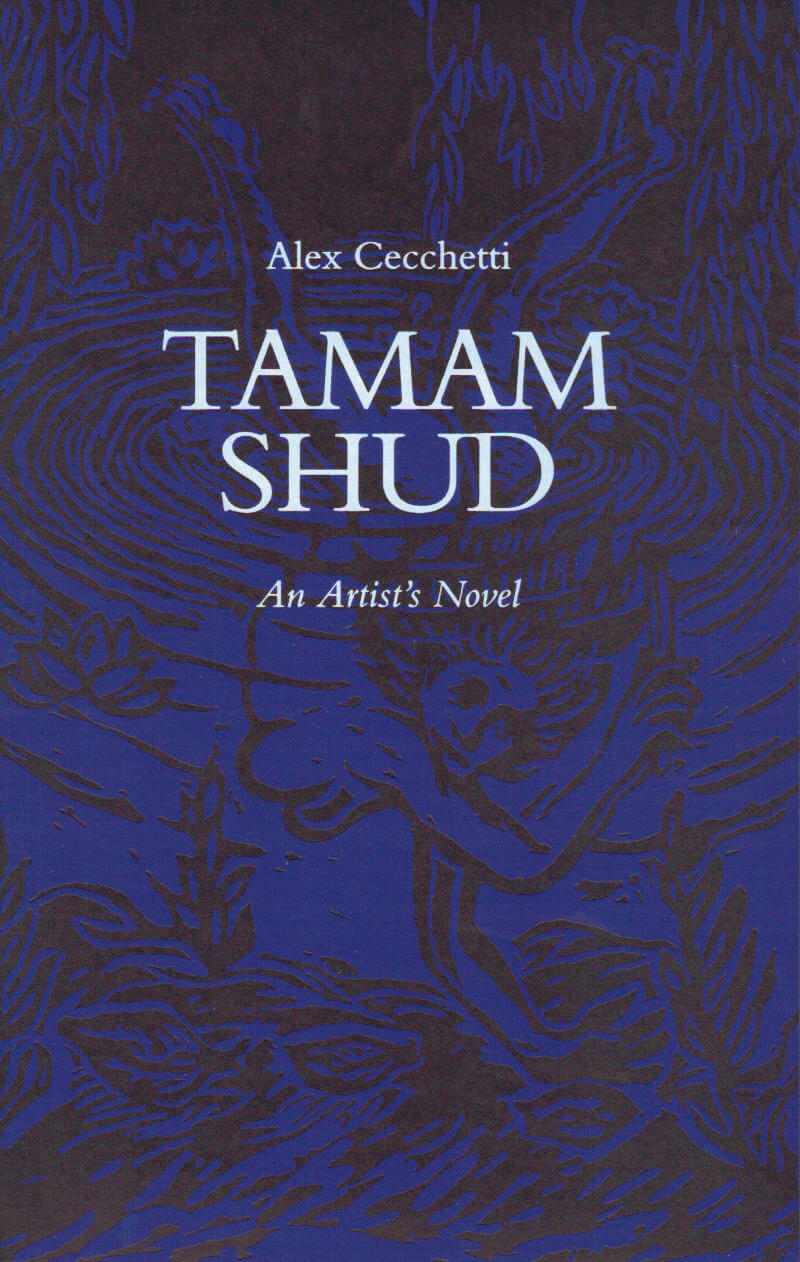
Tamam Shud
A mystery murder artist's novel by Alex Cecchetti, in which the artist and narrator realises he is dead and decides to investigate the causes of his own death.
“I am dead. Homicide, assassination, accident, suicide, the detectives have come up with nothing. The labels in my clothes, my fingerprints, my shoe size, everything has been unstitched, erased, wiped away, blanched, bleached, and consigned to oblivion. As the only clue, in a secret pocket sewn into my trousers, the detectives found a flimsy slip of paper torn from the pages of a book. On that folded bit of paper just two words, Tamam Shud, “this is the end.” Experts, antiquarians, and opium smokers have been consulted, and all agree that these are the last two words in the Rubaiyat, an ancient collection of esoteric poems written by a Persian poet named Omar Khayyam. What the hell do I have to do with poetry, Persia, and hidden pockets? I can't even sew on a button. My identity is still unknown and not even I remember much. This is why I have decided to investigate my own death.”
The Tamam Shud narrative emerged through a series of episodic performances and an exhibition by Alex Cecchetti at the Ujazdowski Castle Centre for Contemporary Art, Warsaw. For two years the writing process and the artistic process were interwoven, feeding each other as they evolved. The art project and the artist's novel are linked together as much as the life of the victim is connected to the piece of paper found in his pocket.
Artist, poet and choreographer, creator of performances and idiosyncratic objects, Alex Cecchetti (born 1977 in Terni, Italy, lives and works in Paris) has developed a unique practice, difficult to classify, that could be called art of avoidance: tactical and poetic, aesthetic and materialistic, its system leads to produce specific situations or objects that can exist both inside and outside the traditional exhibitions. It is in this double movement of representation and conceal that it's possible to inscribe his staging of invisible choreographies of hidden nudes and sleeping dancers. His work is focused in the construction of specific narratives that are experienced both mentally and physically by the audience.

Eine Pinot Grigio, Bitte
A drama in three acts on the main theme of zombies: the most recent novel by the artists' collective.
Eine Pinot Grigio, Bitte is a screenplay that cannot be a film; it is a film that can only be on paper. If the property of a film producer, Bernadette Corporation claims Eine Pinot Grigio, Bitte would be left derelict, abandoned to vagabonds and squatters. It is intended as a narrative of messy revenge, ruined by the screenplay form. With Eine Pinot Grigio, Bitte, Bernadette Corporation asks: How many amateur screenplay writers are there in existence compared to how many amateur novelists? What is the difference between a zombie and an insane cannibal?
Bernadette Corporation is an anonymous artists' group with changing members. From 1995 to 1997, it worked under the guise of an underground fashion label. In 1999 it self-published a magazine, Made in USA, and began producing videos, most notably Get Rid of Yourself (2003). In 2005 Bernadette Corporation authored the much-acclaimed collective novel Reena Spaulings, published by Semiotext(e) and hailed as "[a] sprawling work of crypto-impressionistic fiction that purposefully elides individual authorship for a sort of rarefied mechanical groupthink."

Rīgas cirks Riga Circus
A kaleidoscopic peek into the traditional circus of Riga.
The circus is a drama that extends its own means, and the metaphor of its name (itself clowning around with the word) is widespread across the art industry, financial world, and, of course, anything to do with performance. For four years during the mid-aughts, Ieva Epnere immersed herself in the life of the Riga Circus—a type of traditional circus that cherishes the respectful use of animals, operating on a circus-family model (skills are passed down through generations to produce family units that travel and live on the road), and the big top tent (the landmark interior of one of the oldest circus structures, built for this purpose in Europe since 1888) as a performance space.
This publication, that was developed during Ieva Epnere's fellowship with the Artists-in-Berlin Program of the DAAD, symbolically marks four stages of her single, larger work. Fine-tuned digital color shots, a collection of black-and-white 35 mm film prints showing action at the Riga Circus, followed by a burst of color shots and black and white photos taken on a film camera, to end with a set of intimate black-and-white portraits of the performers. Whereas the conversion of circus into text might to some degree be a violation of the true nature of its subject, Ieva Epnere's book—with the help of elephants, clowns, all the "freakery," and her kaleidoscopic peek into the machinery that makes performances in the arena possible – itself stands as an adventurous act of reinvention.
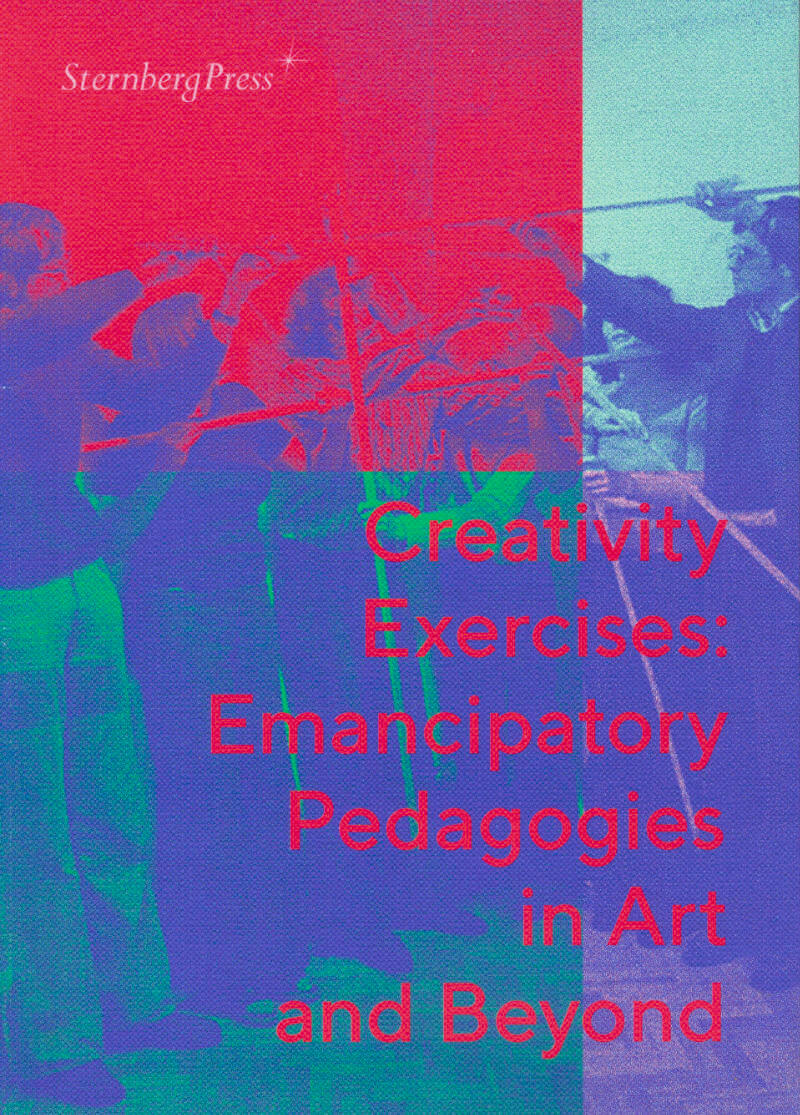
Creativity Exercises
Franciska Zólyom, Zsuzsa László and 1 more
The book contextualizes the Creativity Exercises—an amateur art course led by neo-avant-garde artists Miklós Erdély and Dóra Maurer in Budapest from 1975 to 1977—within the postwar intellectual networks that connected artists, architects, educators, sociologists and other socially engaged professionals, fostering the exchange of ideas and concepts and making connections between different fields of knowledge.
How do people learn, what do they know, and how does it influence their personality, their behavior and their position in society? These questions were the focus of the research project and exhibition series entitled “Creativity Exercises” between 2014 and 2016, which displayed historical and contemporary art projects experimenting with alternative forms of learning, spanning three exhibition stations: Galerie für Zeitgenössische Kunst Leipzig, tranzit.hu in Budapest, and the Museum of Modern Art in Warsaw.
The first part of the publication consists of historical texts translated into English for the first time, including the exercise descriptions that functioned as the curriculum for the Creativity Exercises, studies written on the methods employed in the Creativity Exercises course, and parallel models for progressive pedagogies and art education. In the second part of the book, newly commissioned essays offer historical and transnational context for the “case study” of the Creativity Exercises course. The impact that such “creativity exercises” had on aesthetic, educational and institutional concepts, and the impulses for participation, co-creation, knowledge production and exchange that they continue to give—even beyond the realm of art—are the central themes of the book.
Texts by Ferenc Mérei & Tamás St. Auby, László Beke, Ildikó Enyedi, Miklós Erdély, Éva Forgács, Janna Graham, Dóra Hegyi, Sándor Hornyik, Zsolt K. Horváth, Emese Kürti, Zsuzsa László, Dóra Maurer, Marion von Osten, Axel Wieder.

Girls Against God Issue #1
In collaboration with cross-disciplinary artist Bianca Casady of music duo CocoRosie, 2013 brought the release of a new print magazine entitled Girls Against God (GAG). A boldly feminist exploration and multi-generational endeavor, GAG deploys the arts to illuminate the oppressive, obsolete nature of traditional, male-defined religions and other patriarchal institutions—“We must resist and reinvent,” Casady declares.
Created in partnership with artist Anne Sherwood Pundyk, GAG’s now out-of-print debut issue is a lushly colorful tabloid-sized print publication, showcasing provocative, original artwork alongside comprehensive interviews and essays with an international cadre of artists.
Issue #1—Antony / Gabby Bess / Melanie Bonajo / Vaginal Davis / Yasmine Hadan / Emely Neu / Kembra Pfahler / Marguerite Stern / Alexyss K. Tylor / Johanna Constantine / Mary Hanlon / Julie Higonnet / Molly O’Brien / Chloe Olewitz / Alice O’Malley / Kara L. Rooney / Jean Marc Ruellan
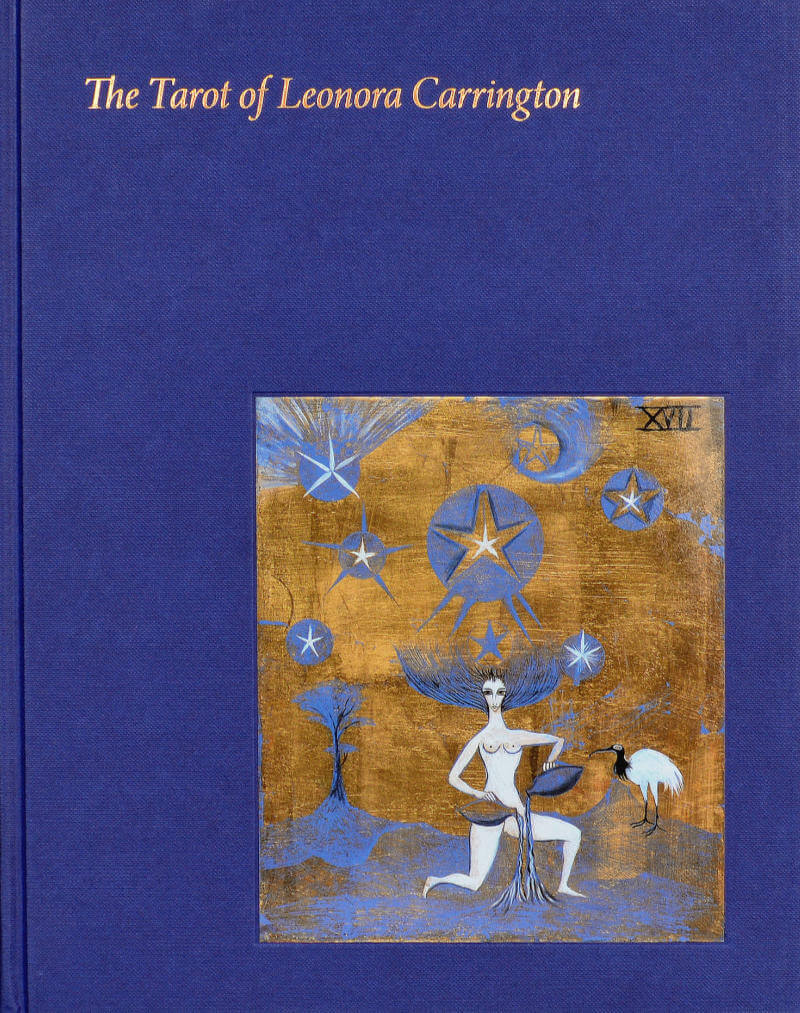
The Tarot of Leonora Carrington
An oracular Surrealism: the debut presentation of Leonora Carrington's recently discovered tarot deck.
The British-born artist Leonora Carrington is one of the more fascinating figures to emerge from the Surrealist movement. As both a writer and painter, she was championed early by André Breton and joined the exiled Surrealists in New York, before settling in Mexico in 1943. The magical themes of Carrington's otherworldly paintings are well known, but the recent discovery of a suite of tarot designs she created for the Major Arcana was a revelation for scholars and fans of Carrington alike.
Drawing inspiration from the Tarot of Marseille and the popular Waite-Smith deck, Carrington brings her own approach and style to this timeless subject, creating a series of iconic images. Executed on thick board, brightly colored and squarish in format, Carrington's Major Arcana shines with gold and silver leaf, exploring tarot themes through what Gabriel Weisz Carrington describes as a "surrealist object." This tantalizing discovery, made by the curator Tere Arcq and scholar Susan Aberth, has placed greater emphasis upon the role of the tarot in Carrington's creative life and has led to fresh research in this area.
The Tarot of Leonora Carrington is the first book dedicated to this important aspect of the artist's work. It includes a full-size facsimile of her newly discovered Major Arcana; an introduction from her son, Gabriel Weisz Carrington; and a richly illustrated essay from Tere Arcq and Susan Aberth that offers new insights—exploring the significance of tarot imagery within Carrington's wider work, her many inspirations and mysterious occult sources.
Leonora Carrington (1917-2011) was born in Lancashire, England. In 1936, she saw Max Ernst's work at the International Surrealist Exhibition in London, and met the artist the following year. They became a couple almost immediately. When the outbreak of World War II separated them, Carrington fled to Spain, then Lisbon, where she married Renato Leduc, a Mexican diplomat, and escaped to Mexico, where she became close with Remedios Varo and other expat Surrealists.
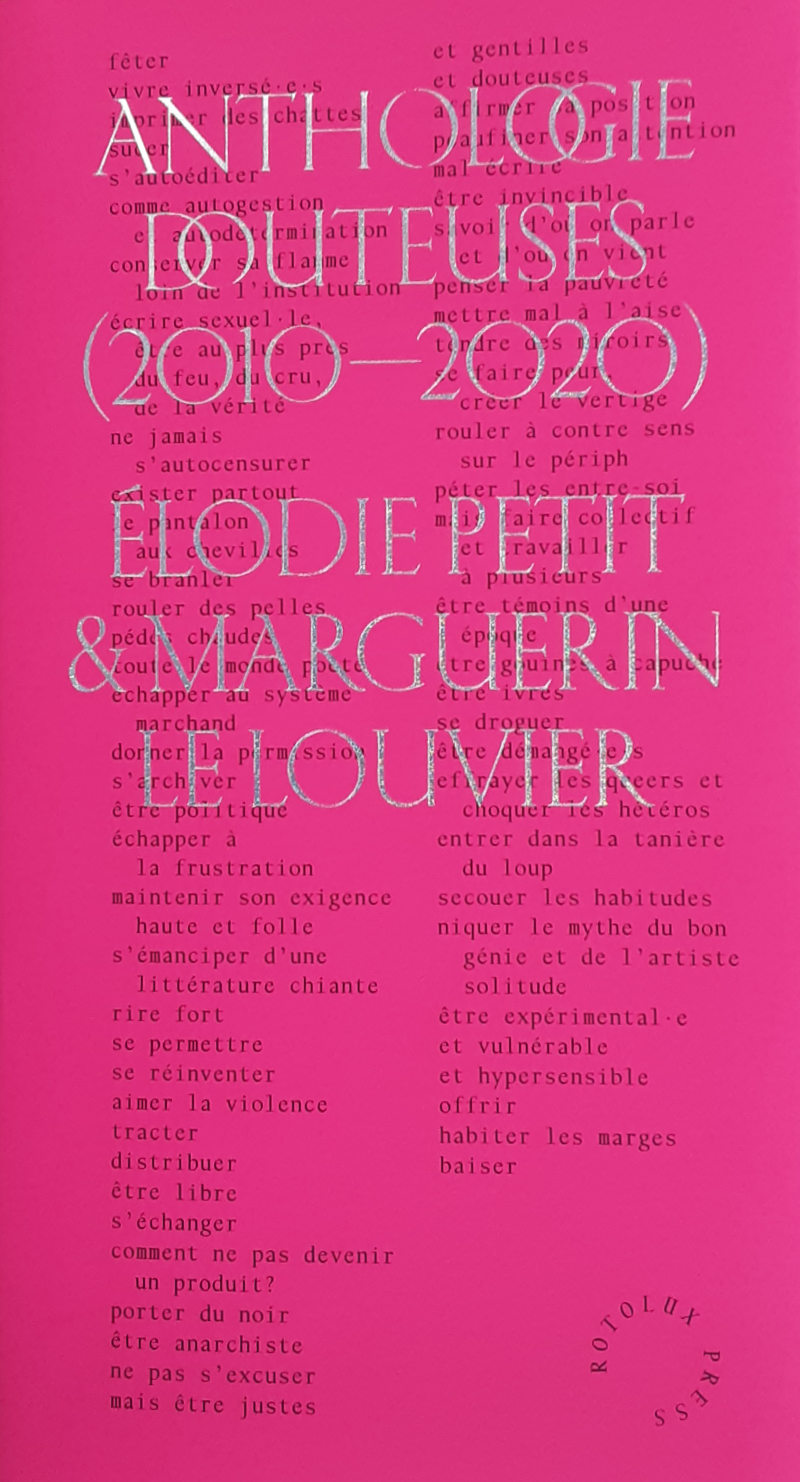
Anthologie Douteuses (2010—2020)
Élodie Petit, Marguerin Le Louvier
Élodie Petit et Marguerin Le Louvier écrivent des poèmes brûlants, sexuels, politiques et les autoéditent depuis leurs chambres sous la bannière commune des Éditions Douteuses. En une décennie, ils produiront des dizaines de textes courts et incisifs, imprimés en noir sur papiers colorés, parfois fluo, formats A5 ou A6 agrafés. À tirages variables, ils seront diffusés lors de soirées lectures-performances dans des bars ou des institutions artistiques, dans des salons de micro-éditions underground ou parfois sous le manteau. L’Anthologie Douteuses (2010—2020) rassemble pour la première fois ces textes en un seul volume, où l’arrangement chronologique donne à voir une certaine évolution de leur pratique littéraire sur dix ans.
« Des incendies savamment allumés au fuel de l’ironie, du fun et du détournement, de la critique sociale et sexuelle, de la pensée radicale et de la poésie merveilleuse. Des contre-feux révolutionnaires joyeusement embrasés par une gouine et un pédé mal repassés du col, qui écrivent, baisent, dessinent, dansent, et s’asseyent en gloussant sur le visage de tous les «culs cousus» et autres suceurs de vieux noyaux. (...) Oui, cette tendresse, leur tendresse, celle d’Élodie et de Marguerin, je crois, nous guérira de tout et leurs merveilleux textes, enfin réunis en un seul et même volume, il faudra les lire quand le courage de vivre, d’aimer et de faire la révolution viendra à nous manquer. Moi, c’est ce que je ferai. » Extrait de la préface d’Anne Pauly.
« Le feu, dans cet ouvrage, est partout invoqué, sussuré, explosé. Il se coule dans les pratiques poétiques queer, matérialistes et révolutionnaires des deux artisan·e·s de ce programme politique. Les éditions douteuses sont un mode d’emploi pour des alliances radicales trans-pédés-gouines-et-au-delà, un appel à une nécessaire profusion-collusion de nos appartenances, de nos situations, et à la production d’intervalles de revendications et de combats partagés. » Extrait de la préface de Thomas Conchou.

Reynaldo Rivera
Lauren Mackler, Hedi El Kholti
Throughout the 1980s and 1990s, Reynaldo Rivera took personal photos of the Los Angeles that he lived in and knew: a world of cheap rent, house parties, subversive fashion, underground bands, and a handful of Latino gay and transvestite bars: Mugi’s, The Silverlake Lounge, and La Plaza. Most of these bars are long closed and many of the performers have died. But in Rivera’s photographs, these men and women live on in a silvery landscape of makeshift old-style cinematic glamour, a fabulous flight from unacceptable reality.
As a teenager, Rivera took refuge in used bookstores and thrift stores, where he discovered old photo books of Mexican film stars and the work of Lisette Model, Brassai, and Bresson. Inspired, he bought a camera and began photographing people at his hotel. In 1981 he moved to Echo Park and began taking photos for the LA Weekly.
This book is an ensemble of almost 200 images selected by Hedi El Kholti and Lauren Mackler spanning more than two decades in Los Angeles and Mexico. The book also includes Luis Bauz’s story, “Tatiana,” about one of the subjects of these photographs; a critical essay on Rivera’s work by Chris Kraus; and a novella-length conversation between Rivera and his friend and contemporary Vaginal Davis about their lives, work, fantasies, and collective histories.
Edited by Hedi El Kholti and Lauren Mackler
With Luis Bauz, Vaginal Davis and Chris Kraus
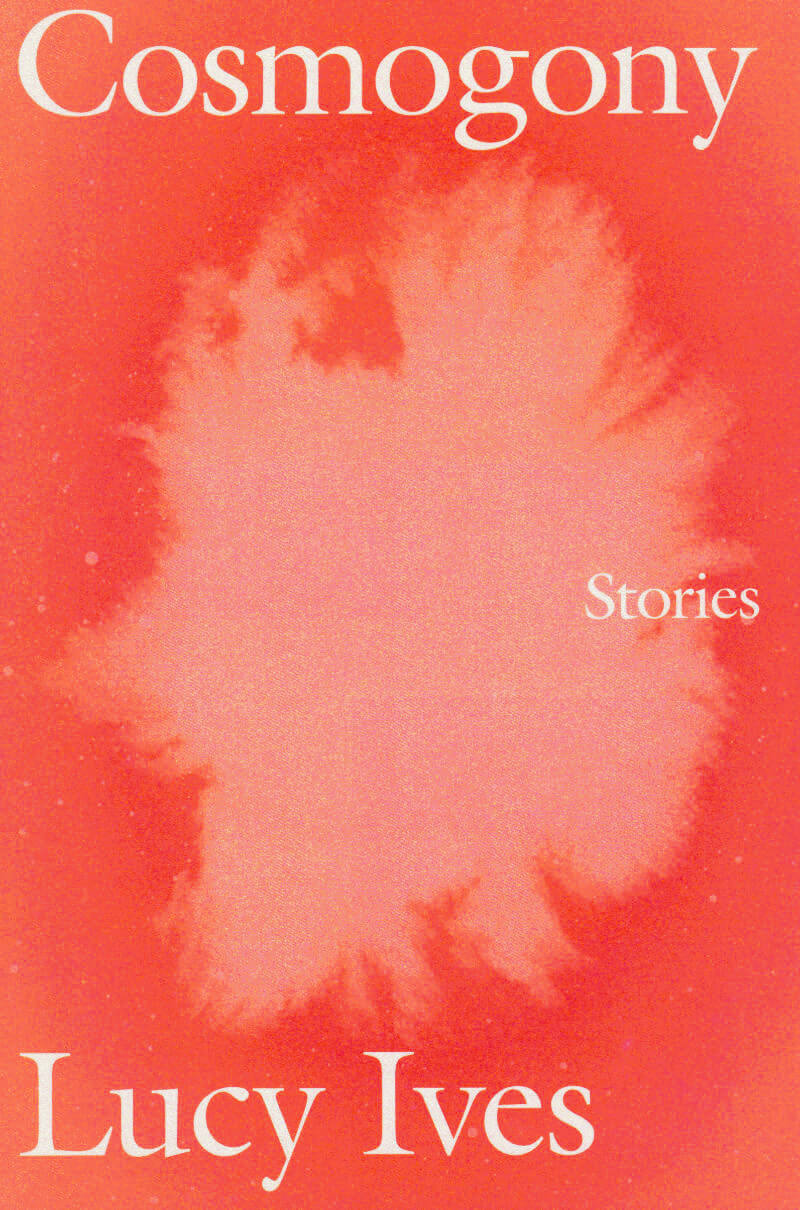
Cosmogony
An energetic, witty collection of stories where the supernatural meets the anomalies of everyday life, deception, infidelity, lost cats, cute memes, amateur pornography, and more.
There are analogies between being female and being left-handed, I think, or being an animal.
A woman answers a Craigslist ad (to write erotic diaries for money). A woman walks onto a tennis court (from her home at the bottom of the ocean). A woman goes to the supermarket and meets a friend's husband (who happens to be an immortal demon). A woman goes for a run (and accidentally time travels).
Cosmogony takes accounts of so-called normal life and mines them for inconsistencies, deceptions, and delights. Incorporating a virtuosic range of styles and genres (Wikipedia entry, phone call, physics equation, encounters with the supernatural), these stories reveal how the narratives we tell ourselves and believe are inevitably constructed, offering a glimpse of the structures that underlie and apparently determine human existence.

Paris la consciencieuse : Paris la guideuse du monde
Frédéric Bruly Bouabré (1923-2014) is an Ivorian artist, poet, “re-searcher”, creator and inventor of the Bété syllabary. In 1989, he was thrust to the front of the international artistic scene during the Magiciens de la terre exhibition (May 18 – August 14, 1989, Centre Georges Pompidou, Grande Halle de La Villette, Paris). Introduced alongside a hundred other artists from all over the world, he would subsequently become world famous for his drawings on maps enhanced with colored pencil.
But in May of that year, Bruly Bouabré still cherished quite a different dream: that of becoming a writer. As he was getting ready to fly to Paris, leaving African soil for the first time, the poet was commissioned by his friends Odile and Georges Courrèges (then director of the French Cultural Center of Abidjan) to write the story of his trip. This is how, a few weeks after his return, Frédéric Bruly Bouabré would submit his “report” of 325 handwritten pages produced in “33 days”, in which he gleefully recounts his journey – at times punctuated by insignificant events – while questioning the place of Man in Western society.
Until now, this tale of “a blind man in Paris,” as he first was to call it, had remained unpublished. The text – of pleasing findings and enchanting language – is that of an observer seeking to understand a changing world, with his own culture as a starting point. Imbued with such freedom and desire for identification and documentation, which characterize the work of this encyclopedic creator, the book is a very unique testimony to a milestone in the history of contemporary art.
Initiated by Odile and Georges Courrèges, who provided publishers with a copy of the manuscript entrusted to them by the artist, the project for this publication was also made possible thanks to André Magnin, who provided the original manuscript.
Foreword by Jean-Hubert Martin
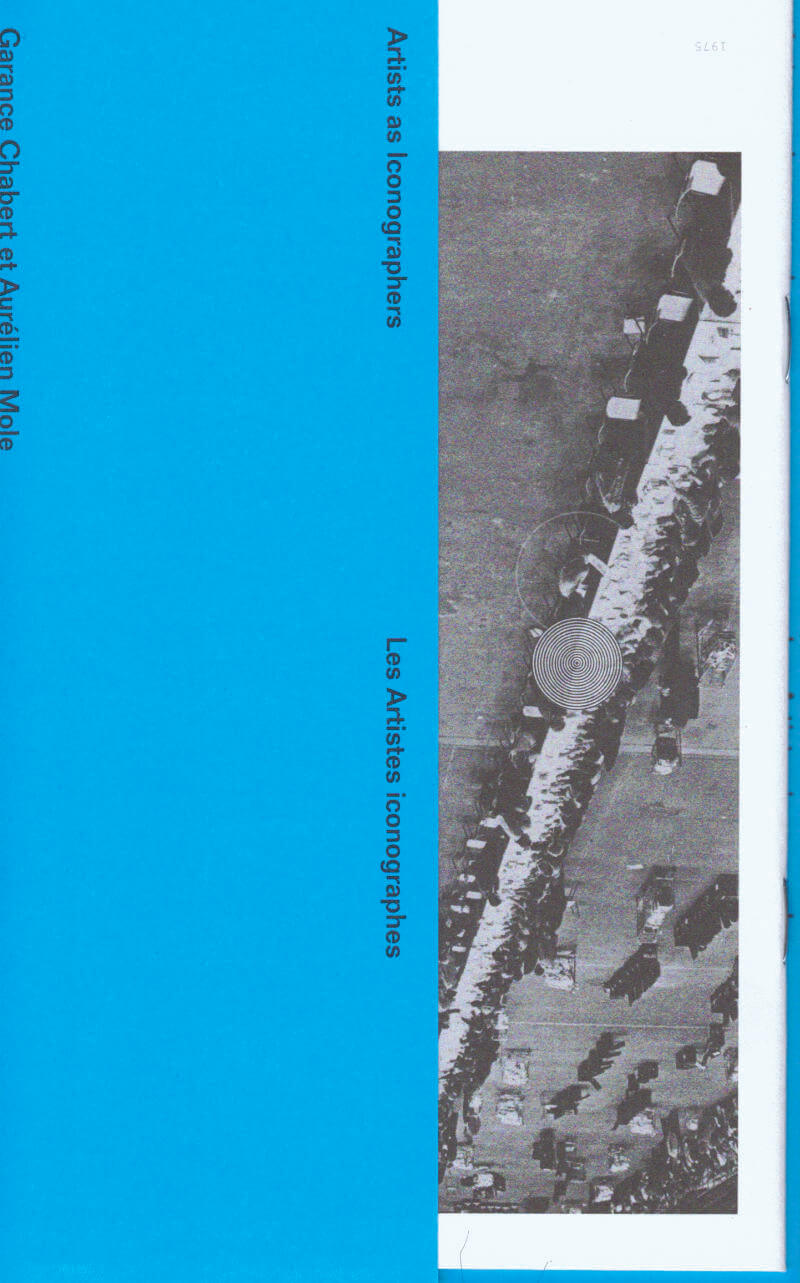
Artists as Iconographers
Aurélien Mole, Garance Chabert
For over a century now, iconographer artists have fuelled their approach by tapping into the diversity of images produced by othersand spread through society by industrial means. From collage to the post-internet school, from archival installations to Appropriationist quotation and image constellations, the present book puts these art practices into perspective, focusing on the last forty years, an extraordinarily dynamic period that recently witnessed the invention and development of a new way of disseminating information and images, the internet. Through theoretical texts, artists’ interviews, and exhibition practices, the book maps the connections artists maintain with images and examines emotion as the driving force in our interactions with them.
Editors: Garance Chabert & Aurélien Mole
Texts: François Aubart, Garance Chabert & Aurélien Mole, Ingrid Luquet-Gad, Jan Verwoert.
Interviews: Pierre-Olivier Arnaud, Barbara Breitenfellner, Céline Duval, Haris Epaminonda, Aurélien Froment, Wade Guyton, Camille Henrot, Thomas Hirschhorn, Pierre Leguillon, Jonathan Monk, Clément Rodzielski, Linder Sterling, John Stezaker, Oriol Vilanova, by Timothée Chaillou.
32 pages leaflet, Turmoil, Batia Suter, 2020, layered reproductions excerpt from a series in progress, various size. Courtesy of Batia Suter.
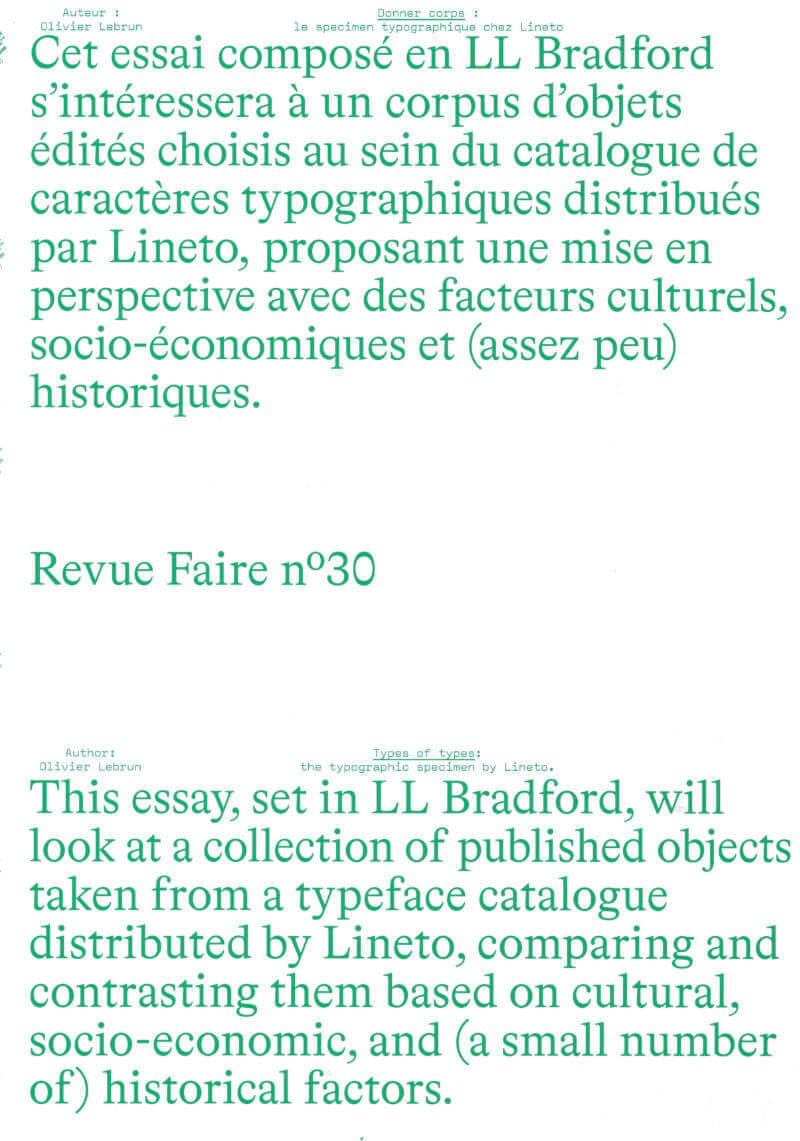
Revue Faire n°30: Types of types: the typographic specimen by Lineto
For Lineto (https://lineto.com) the Specimen plays out through forms and formats in order to promote the foundry’s typefaces: books, posters, envelopes, pamphlets, letter transfers, print ads, and video clips as well as inflatable structures and bootlegs of logotypes. When Reala published LL Biff in 2000, the specimen employed graffiti culture and its modes of distribution, along with a combination of two references: “Medium is the message”*, “Style is the message”**. For Lineto the citation is a form that allows them to distribute their typographic catalogue while promoting diverse cultural fields: “Ignorance of your own culture is not considered cool!”***
* — Marshall McLuhan, Understanding Media: The Extensions of Man, 1964
** — Tony Silver and Henri Chalfant, Style Wars, 1983
*** — Print ad for Lineto published in Dot Dot Dot #16, 2008 that cites The Residents, Duck Stab Poster, 1978
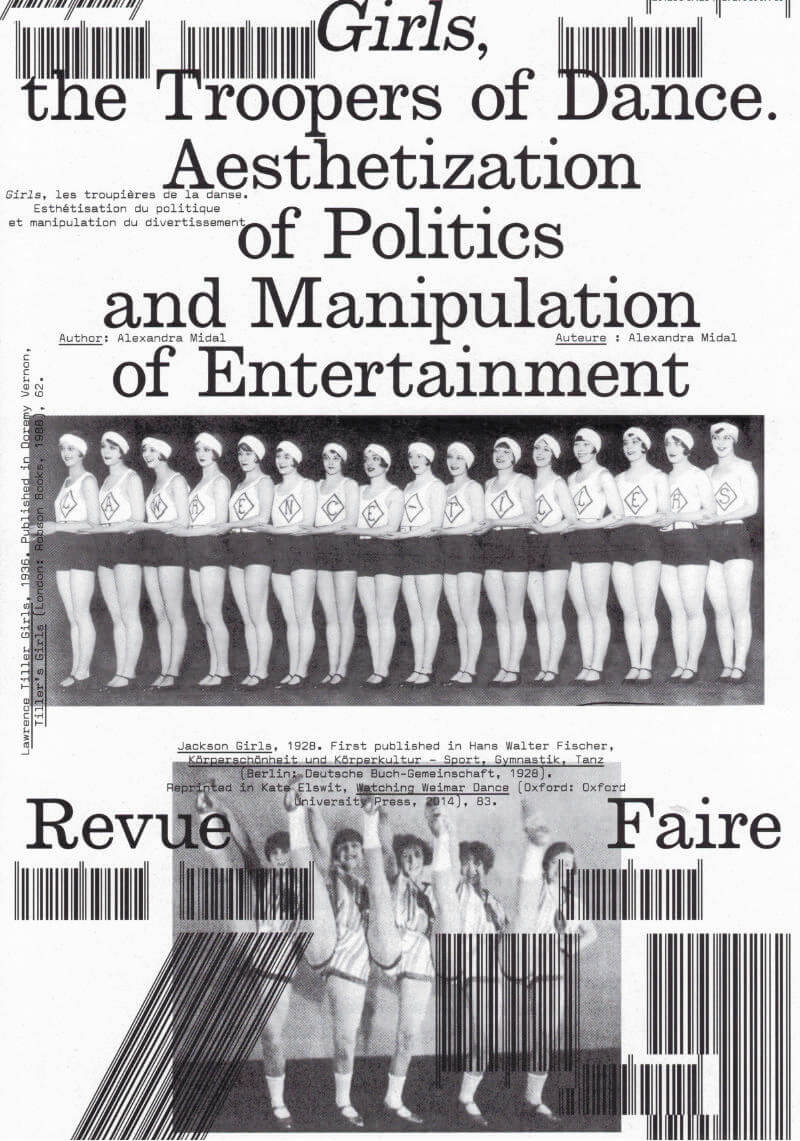
Revue Faire °29: Girls, the Troopers of Dance
The British origins of synchronized dancing—invented in 1880 by John Tiller in a cotton mill—were quickly forgotten in Berlin, where periodicals established themselves as the expression of standardization and American capitalism. The famous Tiller Girls had become the modern figure of the “New Woman”, performing in shows attracting more than four million spectators each year. A seduced Hitler asked for his own troupe: the Hiller Girls. Face to face, both periodicals look like strictly indistinguishable replicas, apart from their opposite messages.
Synchronized dancing revealed the democratic and fascist forms given to the political discourse of the Weimar Republic when the NSDAP seized power. Between the power of forms and forms of power, amid the destruction of cities, decrees banishing the use of Fraktur, and the destruction of degenerate art, those dance shows, undoubtedly because of their popularity, showed that National Socialism was using insidious and invisible strategies to empty forms of their content only to maintain their appearance intact, thus revealing a shadow practice that, in the end, turned out to be just as barbaric as world-wide destruction or the burning of books.
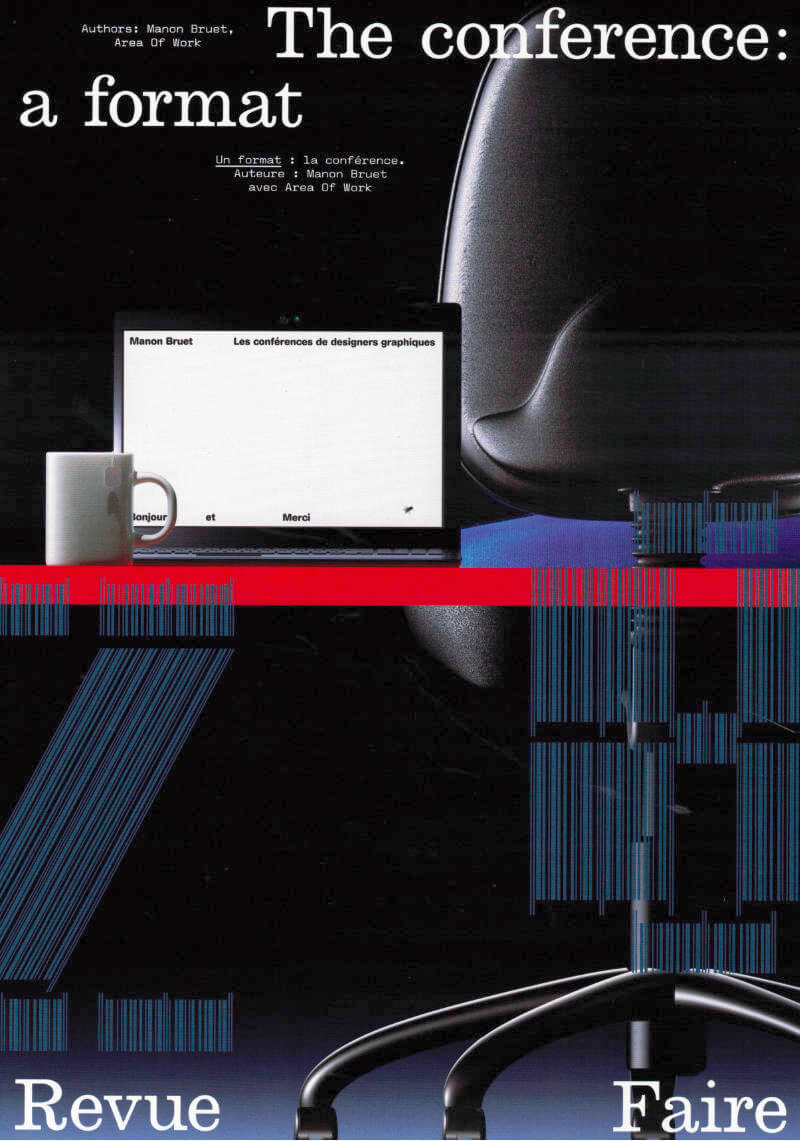
Revue Faire n°28: The Conference: A Format
There are an increasing number of spaces in the field of Graphic Design where work can be promoted. Intermediary platforms between practitioners and the public can come in the form of specific tools (Instagram, for example) or even events that are organized for that purpose (festivals and exhibitions). The conference is one of these platforms. A true ephemeral editorial object, it is highly suited to the explanation and extension of the practices and methodologies of designers. It is, for certain designers, the opportunity to take stock of an approach, an inventory of finished forms, and for others, on the contrary, a pretext for the production of new, sometimes more performative, even experimental forms.
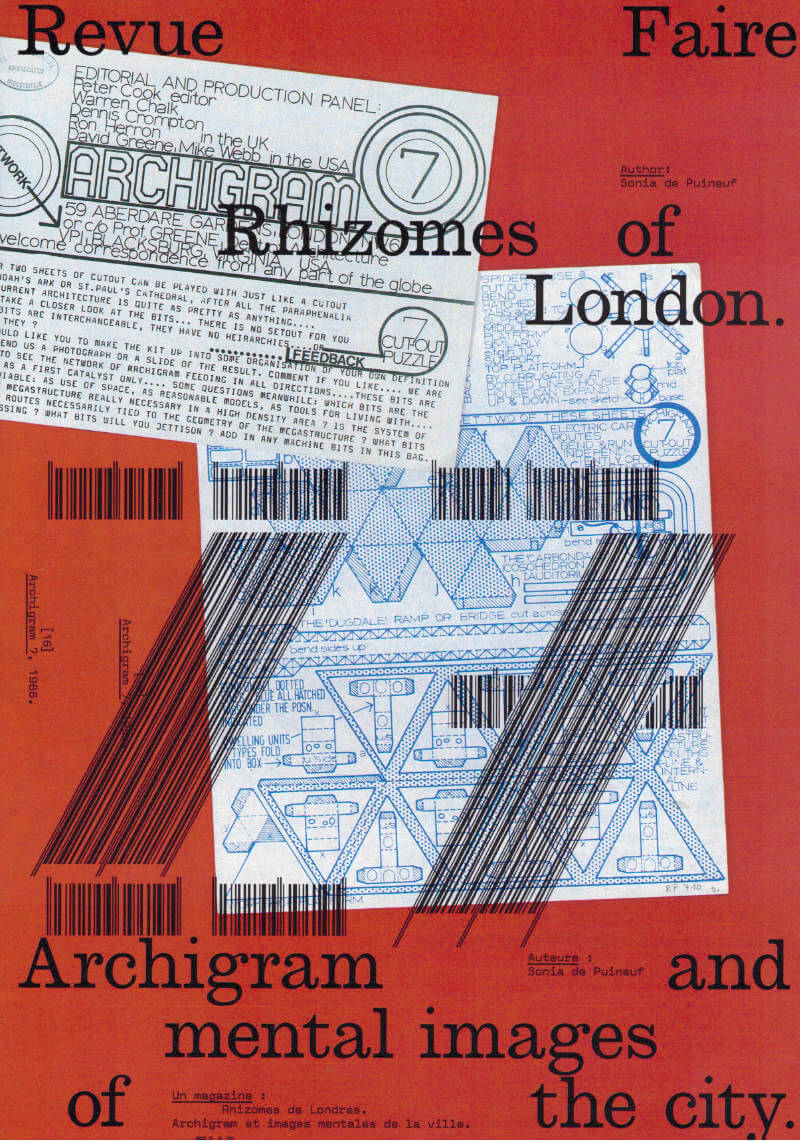
Revue Faire n°27: Rhizomes of London
A mine of images and ideas for architectural and urban-planning practices, the journal Archigram (1961–70) has already been the subject of close reading and analysis by architects, historians, theoreticians, and architecture critics. This study approaches Archigram from a different angle, attempting to interpret it as a successful artifact of graphic design by confronting it with the achievements of its time and other inspirational eras of editorial and environmental graphic design.
It aims to explain the graphical evolution of the journal through the graphical stimuli of London—the city where the Archigram architects worked on a daily basis. It is an attempt to demonstrate that the publication, at first glance confusingly heterogeneous, is akin to a comprehensive mapping of the secret whirrs and the more obvious trends of the English metropolis, where the futuristic utopia of the dynamic city took shape in such a particular way. By identifying London’s potential during the mythical Sixties, the Archigram journal stands out as a rhizomatic image, a living mirror of the urban organism.
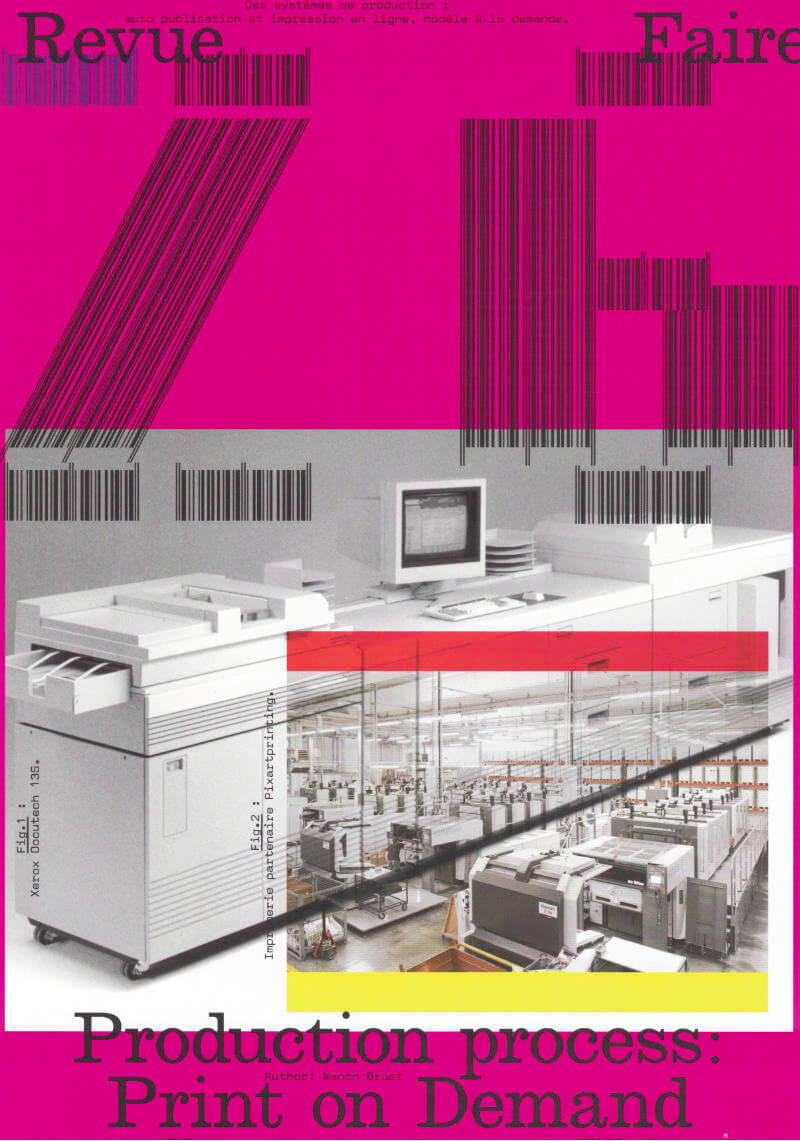
Revue Faire n°26: Production Process
In 2008, English Graphic Designer James Goggin ran a two-day workshop with design students at the Hochschule Darmstadt in Germany. The object which resulted gradually took on the appearance of a photo album, a typeface specimen, and a color chart. On the cover, the phrase “Dear Lulu, Please try and print these line, color, pattern, format, texture and typography tests for us” is clearly addressed to the online print platform for which this book was proposed as a test.
Ten years later, the offer has become more diverse and the success of such online platforms is undeniable—indeed the phenomenon has spread well beyond the field of publishing. While some bemoan unfair competition for printers, others, professionals and amateurs, see in it a freedom to print and distribute relatively well finished objects at low cost.
The possibilities of these systems of production, are multiple but nonetheless limited, and this obviously raises the question of a possible standardization of forms and formats. However, when it comes to Print On Demand, it seems that the issue is not so much the materiality of an object (the choice of format, paper or a particular manufacture) but rather the actual existence of this object itself, outside of usual channels of production and distribution.

Revue Faire n°25: Exhibition Views?
Photographs of works of art in an exhibition or studio setting, enlarged to the size of the wall, have become an essential and increasingly systematic element of contemporary museography. The institutional curator accompanied by his or her set designer, and the independent curator, both use them as much to recontextualize works as for their aesthetic qualities as documentary images that have become immersive and reflexive.
The obviously richer relationship that artists have with these unique images reveals in various ways what is currently at stake in the act of exhibiting.
To create a kind of retrospective of his work, in 2016 Johnathan Monk debuted a series of exhibitions entitled Exhibit Model*, which consisted of covering the walls of the exhibition space with archive photographs that documented his work in different contexts over the last 20 years. Marie J. Jean considers these staged exhibition views as a form of augmented reality: “This manner of considering the exhibition, in other words, of exhibiting the work along with the context of its appearance, reminds us that the work of art “is a place”, “establishes a place”, is “a has taken place**”.
However for Johnathan Monk, who often uses the work of other artists, isn’t it simply a way in which to appropriate his own work?”

Revue Faire n°24: A Theater Identity
Designed by Cornel Windlin (with Gregor Huber), the communications of the Zürich Schauspielhaus for the 2009/10 and 2010/11 seasons appeared just as the collaboration between the designers and the theater ended: with the Grand Prix of the Brno Biennial in 2010, where they won first prize in the international competition, with an exhibition in Chaumont the following year at the same time as the Swiss Federal Design Award, a brief appearance in specialist magazines and on specialist sites, and then nothing at all.
Once again, Cornel Windlin retreated into the shadows, leaving behind work which asserted itself through both its amplitude and completeness in the heavy silence which remained, and through the multifaceted mass of the media imagery that it reactivated. A series of seasonal posters, event posters, annual and monthly programs, booklets dedicated to each piece, invitations, flyers, graphic materials from the program for younger audiences… everything is here, set in a precisely tuned bold Unica77, digitized by the Lineto foundry with the original team of designers (along with Windlin), all coming together in that blindness inherent to times of eclipse, where the black disk chosen by Windlin as the identity of the Schauspielhaus stands out. Now, a decade later, the idea is to propose a meticulously organized reception, informed by Cornel Widlin and placed in a cavalier perspective by the analysis of Thierry Chancogne.
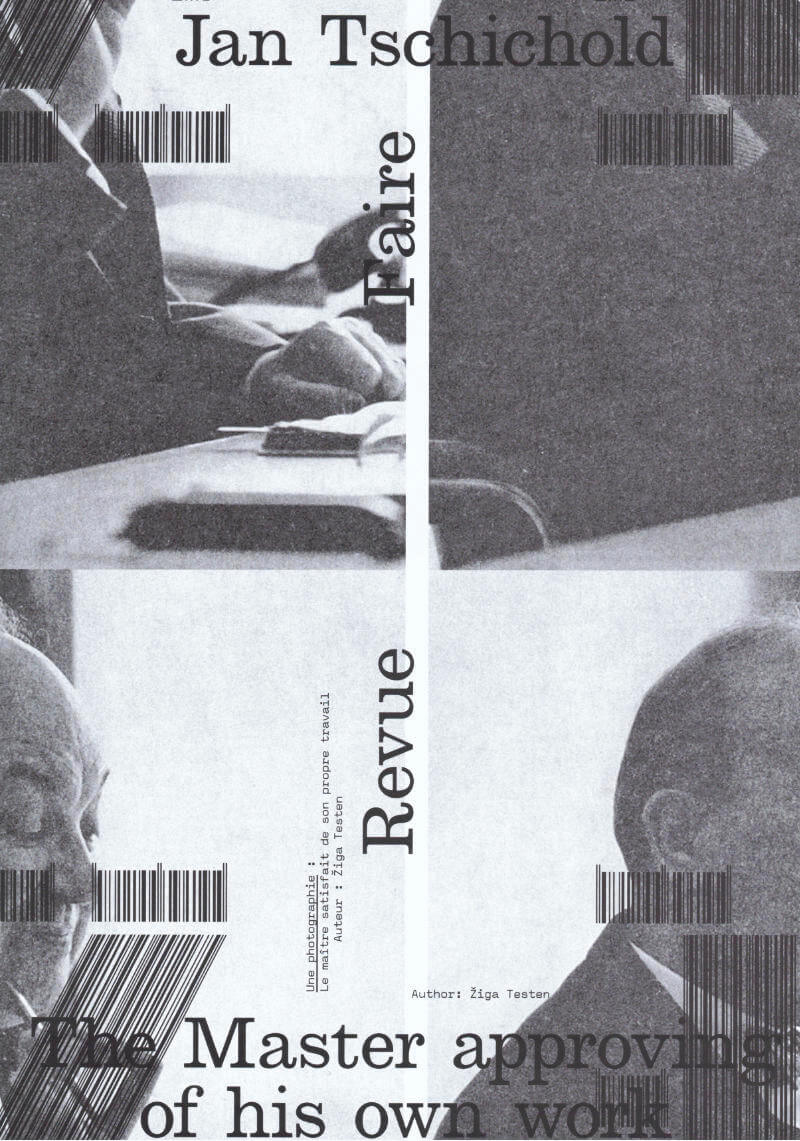
Revue Faire n°23: A Portrait
Design history as an independent discipline and field of study appears to be in trouble. Design historians complain about its diminishing influence within universities due to the ongoing instrumentalisation of higher education. The Eurocentric canon built upon values and methods adopted from art and architecture history has been contested by decolonial theories. And finally, it appears that the trust in the institution of ‘history’ itself and its meta-narratives has eroded.
A discipline that was once considered to provide reflection on what came before and guidance on what could come to be—under the auspice of a grand narrative of continuous progress—has been replaced by modest narratives, social anthropologies, and claims of the ‘end of history’.
In this article, I rummage through the ruins of design history and try to unpack what it was that we once considered design history and our design history canon, how we wrote about it and to what end. In particular, I focus on this one image: a portrait photograph of a well-known historical figure, the designer and typographer Jan Tschichold. How is it used? And what stories do we tell about it?
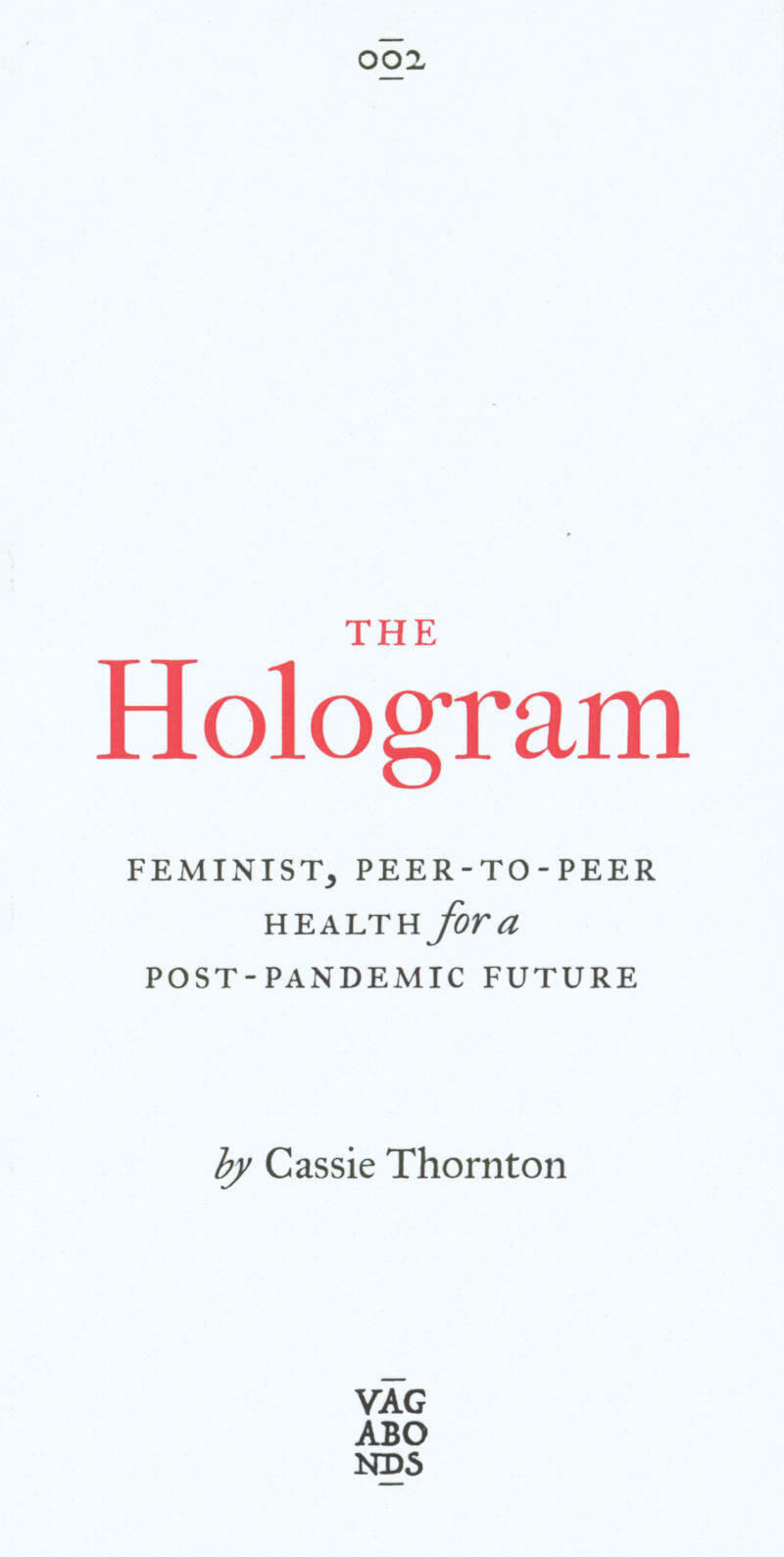
The Hologram: Feminist, Peer-To-Peer Health for a Post-Pandemic Future
In an era when capitalism leaves so many to suffer and to die, with neoliberal 'self-care' offering little more than a bandaid, how can we take health and care back into our hands? In The Hologram, Cassie Thornton puts forward a bold vision for revolutionary care: a viral, peer-to-peer feminist health network. The premise is simple: three people - a 'triangle' - meet on a regular basis, digitally or in person, to focus on the physical, mental and social health of a fourth - the 'hologram'. The hologram, in turn, teaches their caregivers how to give and also receive care; each member of their triangle becomes a hologram for another, different triangle, and so the system expands. Drawing on radical models developed in the Greek solidarity clinics during a decade of crisis, and directly engaging with discussions around mutual aid and the coronavirus pandemic, The Hologram develops the skills and relationships we desperately need for the anti-capitalist struggles of the present, and the post-capitalist society of the future. One part art, one part activism, one part science fiction, this book offers the reader a guide to establishing a Hologram network as well as reflections on this cooperative work in progress.
Cassie Thornton is an artist and activist from the US, currently living in Canada. She refers to herself as a feminist economist, a title that frames her work as that of a social scientist actively preparing for the economics of a future society that produces health and life without the tools that reproduce oppression, like money, police or prisons.

The Dispossessed
A bleak moon settled by utopian anarchists, Anarres has long been isolated from other worlds, including its mother planet, Urras, a civilization of warring nations, great poverty, and immense wealth. Now Shevek, a brilliant physicist, is determined to reunite the two planets, which have been divided by centuries of distrust. He will seek answers, question the unquestionable, and attempt to tear down the walls of hatred that have kept them apart.
To visit Urras, to learn, to teach, to share, will require great sacrifice and risks, which Shevek willingly accepts. But the ambitious scientist's gift is soon seen as a threat, and in the profound conflict that ensues, he must reexamine his beliefs even as he ignites the fires of change.

Women, the New York School, and Other True Abstractions
"Nelson's revision of the New York School makes it not only more diverse but also more resistant of defining tropes. By showing how a motley collection of poets and artists defied the gendered conventions of both the aesthetic status quo and the so-called experimental, Nelson restores the avant-garde to its raison d'etre: to lead us past orthodoxy to discovery."—Modern Painters
"Nelson has produced the kind of boundary-busting scholarship perhaps most likely to push the field toward greater clarity concerning its parameters, urgent questions, and dramatis personae."—American Literature
“After decades of listening (enthralled, of course) to the knitted ribbon-dress observations of John Ashbery, Frank O’Hara, and James Schuyler, finally, the other serious ladies of the necessarily ‘so-called’ New York School—Joan Mitchell, Barbara Guest, Bernadette Mayer, Alice Notley, and Eileen Myles—are invited to give their full-throated response. Smart as a whip and fun as an after-hours bar, Maggie Nelson gets fresh with heretofore queerly ignored matters poetic, aesthetic, and feminist. Rearranging the school’s classroom seating, illuminating details, all the while demonstrating how crucial not-caring is to care, Nelson remaps the ‘one flow’ of poetry. Let me be blunt: reading her bravura study’s like spying Joan Jett taking Helen Vendler for a joyride.”—Bruce Hainley
“This is a terrific and necessary book. . . . Maggie Nelson charts new paths for work on the New York School and on postwar experimental writing, and her book will be necessary reading for anyone working in the area—it will reach poets and other writers, visual artists, and scholars interested in the New York School and in avant-garde or experimental work; it will reach readers interested in women’s contributions to the arts, urban culture, and the history of New York City.”—Susan Rosenbaum, University of Georgia, author, Professing Sincerity: Modern Lyric Poetry, Commercial Culture, and the Crisis in Reading
“So many times over the years I’ve been asked, What’s it like to be a woman in rock music? It’s always been sort of a paralyzing question—to answer it is to give the question itself meaning. Maggie Nelson here opens it all up for examination with this incredibly timely and astute book.”—Kim Gordon of Sonic Youth
“Maggie Nelson is deft and revelatory in bringing sociological as well as psychological, stylistic, and political insights to bear on her title terms, ‘women’ and ‘the New York School.’ She lays bare an obscured history, performs imaginative and incisive readings of careers as well as books and poems, and foots her way with exciting skill through the overlapping minefields of professional, national, and sexual politics.”—Eve Kosofsky Sedgwick, author, A Dialogue on Love
In this whip-smart study, Maggie Nelson provides the first extended consideration of the roles played by women in and around the New York School of poets, from the 1950s to the present, and offers unprecedented analyses of the work of Barbara Guest, Bernadette Mayer, Alice Notley, Eileen Myles, and abstract painter Joan Mitchell as well as a reconsideration of the work of many male New York School writers and artists from a feminist perspective.
With contagious enthusiasm, Women, the New York School, and Other True Abstractions ranges widely and covers collaborations between poets and painters in the 1950s and 1960s; the complex role played by the “true abstraction” of the feminine in the work of John Ashbery, Frank O’Hara, and James Schuyler; the intricate weave of verbal and visual arts throughout the postwar period, from Abstract Expressionism to Pop to Conceptualism to feminist and queer performance art; and the unfolding, diverse careers of Mayer, Notley, and Myles from the 1970s to the present. Along the way, Nelson considers provocative questions of anonymity and publicity, the solitary and the communal, the enduring and the ephemeral, domesticity, boredom, sex, and politics.
By asking us to rethink the ways in which we conceptualize “schools” and “avant-gardes” and eventually drawing our attention to larger, compelling questions about how and why we read—and how gender and sexuality inform that reading in the first place—Maggie Nelson not only fills an important gap in the history of American poetry and art but also gives an inspired performance of the kind of lively, audacious, and personally committed criticism that befits her subject.

The Marathon Poet
Iconic poet-artist of the Swedish post-war avant-garde, Ake Hodell tells the story of his artistic journey through the absurd, satirical, tour-de-force that is THE MARATHON POET, originally published in 1981 and now available for the first time in a facsimile-style English translation.
Hodell's book is centered around a fictional race between poets, in which our author-protagonist becomes the sole qualifier after some fitness and alcohol tests. The narrative of the race is intersected by apocryphal origin stories of Hodell's earlier works that freely blur fact and fiction, taking us even as far as Hell to find a publisher for one of his books. Through para-fictional devices, repetitive language techniques, phonetic writing, and satirical humor he continuously mocks authority. Hodell's tall tales unmask and satirize oppression's many guises—from disciplinary speed reading in elementary school to the forced repetition of a military command. In one chapter, Hodell relates the history of capitalism by way of a multi-vocal sound-poem featuring the voices of European and American automobiles. Through all the tribulations experienced by the marathon poet, Hodell's pacifist and anarchist politics are always present, always in solidarity, always in resistance.
In 1941, while serving as a fighter pilot in WWII, Åke Hodell (1919-2000) miraculously survived a plane crash. During his convalescence, he decided to change the course of his life and became a poet and artist, influenced by socially critical art movements as well as by Fluxus. His experiments with language and visual art moved fluidly between a variety of forms and genres, including concrete poetry and artists books (such as igevär and Orderbuch), collage, spoken word, performance, radio theater, sound- and object-based installations, and pioneering sound-art works such as Mr. Smith in Rhodesia and Where is Eldridge Cleaver?

Slow Down and Walk: A Conversation
Nadina George-Graves, Okwui Okpokwasili
In a conversation that took place in August 2020, during a global pandemic and in the wake of mass uprisings across the US against systemic racism and police brutality, scholar and choreographer Nadine George-Graves and performance-maker and dancer Okwui Okpokwasili discuss ideas of collaborative practice, radical forgiveness, virtuosity, and community. Reflecting on Okpokwasili's and Peter Born's practice and installation from March 2020, Sitting on a Man's Head, the two women consider how art making reflects the kind of imagination of how one might live in the world, proposing modes of relation that are neither predatory nor transactional, but grounded in care.
This conversation originally took part as an event for 50WomenAtYale150, and was co-sponsored by Yale Women, the Yale Alumni Association, and the Yale Black Alumni Association.
This pamphlet is part of UDP's 2020 Pamphlet Series: twenty commissioned essays on collective work, translation, performance, pedagogy, poetics, and small press publishing. The pamphlets are available for individual purchase and as a subscription. Each offers a different approach to the pamphlet as a form of working in the present, an engagement at once sustained and ephemeral.
Okwui Okpokwasili is a performer, choreographer, and writer creating multidisciplinary performance pieces that draw viewers into the interior lives of women of color, particularly those of African and African American women, whose stories have long been overlooked and rendered invisible. Her formally experimental productions include Bronx Gothic, Adaku's Revolt, Poor People's TV Room, and Sitting on a Man's Head, and bring together elements of dance, theater, and the visual arts (with spare and distinctive sets designed by her husband and collaborator, Peter Born).